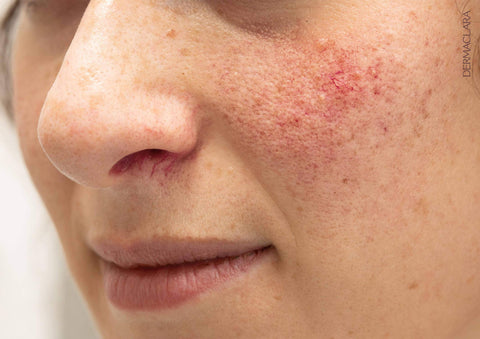Advanced Rosacea Skincare Guide

Welcome to the sophisticated world of advanced skincare, where we're diving into the intricacies of managing rosacea – a condition that requires finesse and a touch of modern skincare know-how.
In this guide, we'll explore the fundamentals of rosacea, its various types, how to identify it, distinguish it from other skin conditions, understand its root causes, and finally, delve into cutting-edge treatments like silicone patches.
What Is Rosacea?
Rosacea is a common skin disorder that primarily affects the face, causing redness and visible blood vessels. It often begins with subtle flushing and can progress to persistent redness, pimples, and even thickened skin.
Types of Rosacea
There are four main subtypes of rosacea, each with distinct symptoms:
Erythematotelangiectatic Rosacea: Characterized by redness, flushing, and visible blood vessels.
Papulopustular Rosacea: Involves redness, swelling, and acne-like breakouts.
Phymatous Rosacea: Results in thickened skin, often around the nose, leading to a bulbous appearance.
Ocular Rosacea: Affects the eyes, causing redness, dryness, and irritation.
Understanding the specific subtype is crucial for tailoring an effective skincare routine and treatment plan.

How to Identify Rosacea
Identifying rosacea involves recognizing its symptoms, which can vary among individuals. Persistent redness, flushing, and pimples or pustules are common signs. Additionally, individuals with rosacea may experience a burning or stinging sensation on their face. Seeking professional dermatological advice is essential for an accurate diagnosis.
Know the Difference
Rosacea vs Eczema: Rosacea is often confused with eczema due to the redness and inflammation both conditions can cause. However, eczema typically involves intense itching, dry skin, and a more widespread rash. Unlike rosacea, eczema can appear on various body parts, not just the face.
Rosacea vs Lupus: Lupus and rosacea share some overlapping symptoms, such as facial redness. However, lupus is an autoimmune disease that can affect multiple organs, leading to more systemic symptoms like joint pain and fatigue. A thorough medical evaluation is crucial to differentiate between the two conditions.
What Causes Rosacea on Face?
The exact cause of rosacea remains elusive, but factors such as genetics, environmental triggers (like sun exposure, spicy foods, and alcohol), and an overactive immune system are believed to contribute. Identifying and avoiding triggers can help manage symptoms.
Rosacea Treatment
When looking for how to treat rosacea, there are several avenues you can take. Below, we identify four effective yet invasive ways for how to get rid of rosacea.
Microneedling for Rosacea
Microneedling, a minimally invasive procedure, has emerged as a promising solution for rosacea. Creating controlled micro-injuries stimulates collagen production, reducing redness and improving skin texture. Administered by professionals, this treatment offers significant benefits without extended downtime.
Laser Treatment for Rosacea
Laser therapy is a cutting-edge approach targeting blood vessels responsible for rosacea-related redness. Dermatologists perform this precise treatment, leading to a visible reduction in persistent red patches and an overall improvement in skin appearance.
IPL (Intense Pulsed Light) Therapy for Rosacea
IPL therapy effectively addresses visible blood vessels and redness associated with rosacea by utilizing high-intensity light pulses. Dermatologists often recommend this non-invasive option to enhance skin tone and minimize redness.
Fractional Laser Treatment for Rosacea
Fractional laser treatment employs fractional photothermolysis to target microscopic skin columns, promoting collagen production and skin renewal. This personalized approach reduces redness and improves skin texture, providing a tailored response to rosacea symptoms.

Rosacea Skin Care Routine Tips
Crafting an effective skincare routine is crucial for managing rosacea. Below, we outline a dermatologist recommended skin care routine for rosacea that soothes and restores the skin.
Use Gentle, Non-irritating Products
Rosacea-prone skin demands products that soothe rather than exacerbate. Opt for fragrance-free cleansers and moisturizers to minimize the risk of irritation. The best skincare for rosacea will feature ingredients like chamomile and aloe vera, known for their calming properties. Prioritize formulations designed for sensitive skin to maintain a gentle yet effective skincare routine.
Moisturize Every Day
Consistent hydration is a cornerstone in managing rosacea symptoms. Daily moisturization helps maintain the skin's natural barrier, preventing excessive dryness and minimizing the risk of flare-ups. Seek moisturizers with ingredients like ceramides, hyaluronic acid, and glycerin, promoting hydration without aggravating redness or sensitivity.
Choosing the Right SPF for Your Sunscreen
Sun protection is non-negotiable for individuals with rosacea. UV rays are known triggers for flare-ups, making sunscreen a vital component of daily skincare. Choose a broad-spectrum sunscreen with an SPF of 30 or higher. Physical blockers like zinc oxide and titanium dioxide are less likely to cause irritation. Regular and liberal application, especially during prolonged sun exposure, prevents sunlight-related skin reactions.
Ingredients to Avoid in Rosacea Skincare
Understanding skincare labels is pivotal in managing rosacea effectively. Certain ingredients can exacerbate redness and sensitivity, making it essential to steer clear of potential irritants. Alcohol-based products, witch hazel, and high concentrations of retinoids are best avoided. Instead, go for products containing calming ingredients like green tea extract, chamomile, and niacinamide to promote skin comfort and reduce inflammation. These products may not claim to be rosacea skincare products, but if they feature these ingredients, they are good to add to your routine.
Medical-Grade Silicone for Rosacea Prone Skin
Dermaclara is a rising star in skincare for rosacea. The medical-grade silicone patches boost healing properties and provide relief for those prone to rosacea. The patches act as a protective barrier, and help minimize inflammation and redness, soothe breakouts, and restore thickened skin. Dermaclara patches should be a staple in your skincare regimen for managing rosacea, especially if you prefer to avoid the invasive treatments we listed above.
Crafting your advanced rosacea skincare routine may not be easy but know that Dermaclara is by your side. And by incorporating these tips, you can nurture your skin towards lasting comfort and radiance.

Leave a comment